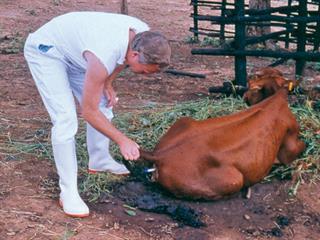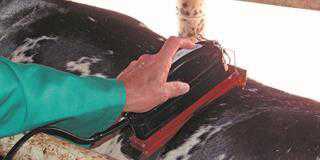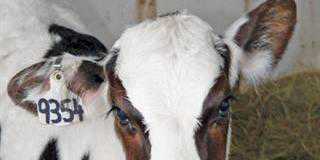
Botulism (lamsiekte) is caused by a toxin rather than an infection. The voluntary motoric muscles, as well as those involved in chewing and swallowing, are affected, resulting in partial or complete paralysis. It can occur in cattle, sheep, goats, horses, donkeys, chickens, ostriches, waterfowl and sometimes pigs. Humans and certain fish species are also susceptible.
The botulism toxin is found in decomposing organic plant or animal material containing Clostridium botulinum bacteria, and is ingested by mouth. Because it is not an infectious disease, a sick animal cannot infect a healthy animal. C. botulinum produces at least seven types (A, B, C1, D, E, F and G) of neurotoxin. Type D is the most important in cattle, Type C1 in chickens, ducks, cattle (to a lesser degree than D) and horses, and Types A,B and E in humans.
In South Africa, toxins from two C. botulinum bacteria types – C and D – are usually involved; these are among the most deadly and are not deactivated by the digestive process. However, they are temperature-sensitive and can be deactivated by exposure to a temperature of 80°C for 10 minutes.
All C. botulinum toxins share a common physiological action. The toxin is a zinc-demanding metalloproteases (a protease enzyme requiring a metal as its catalytic mechanism) that damages specific proteins in the synapses of the nervous system.
C. botulinum bacteria form resistant spores that occur widely in the soil in most parts of the world. They proliferate in decomposing protein-rich animal and plant matter, such as the carcasses of rats, mice, tortoises, hares and birds, as well as in lucerne and bean hay. In this decomposing protein-rich matter, the bacteria produce extremely virulent toxins. If an animal ingests these toxins, they will be absorbed into its digestive system, leading to paralysis within two to six days.
How are animals poisoned?
Horses are the most susceptible of all animals to botulism, while pigs, dogs and cats (carnivores) are highly resistant. Cattle, sheep and goats are equally susceptible. C. botulinum is a normal inhabitant of the digestive system of healthy horses, cattle and chickens, where the bacteria proliferate and are voided in the dung, contaminating the environment.
Switching goats from pasture and silage to hay seems to increase their susceptibility to the toxin.
Pica
In grassveld and grass pasture, the phosphate level of old, moribund grass decreases in winter. If the animals’ diet is not supplemented with phosphate added to the lick or stock water, cattle grazing this grass can exhibit poor growth, weakness in the legs, a stiff gait and pica. The latter is a craving to chew on bones (osteophagy). Old, fibrous grass also lacks protein, further increasing pica. Extended drought makes the situation worse.
Should these bones or any decomposing carcass material, which is often eaten too, contain C. botulinum toxin, the animal will develop botulism. Growing, lactating and pregnant cattle require more phosphate in their diets than others and are more inclined to develop botulism should their phosphate requirements not be satisfied.
Under extensive conditions, pica is the prime cause of botulism in cattle. As far as is known, pica does not occur in other species. Contaminated carcasses in feed Due to its high nitrogen content, chicken litter is often used as a constituent in lick for cattle and sheep. Should it contain decomposing chicken carcasses contaminated with C. botulinum or its toxin, it can cause botulism. The disease has been recorded where contaminated chicken manure was used as fertiliser on pasture and cattle then grazed the pasture.
Carcasses of birds, tortoises and small mammals such as rats and mice are important sources of the botulism toxin for cattle and sheep grazed under extensive conditions. Carcasses of small mammals and tortoises may remain toxic for as long as 350 days, but usually lose their toxicity after four to six weeks. Rain leaches the toxin out of the carcass and washes it away, but the shell and bones of a tortoise retain it for far longer during wet weather conditions. In the presence of sufficient moisture and warmth, a considerable quantity of toxin can be formed in a carcass, but under cold and dry conditions the rate of formation declines dramatically.
Should a rat or cat die in a silage bunker, the botulism toxin produced in the carcass can contaminate the silage around it. Animals eating this silage will then contract the disease. A similar problem can occur when rats die in large bales of hay covered with or wrapped in plastic sheeting. The carcass of a small animal containing the toxin can also contaminate drinking water.
Feed botulism
Rotting protein-rich lucerne and bean hay, as well as brewers’ grain, vegetables, silage and discarded porridge, may serve as a growth medium for the bacteria, causing botulism in cattle and sheep eating it, hence the name voerlamsiekte (feed botulism). Should fermentation during the silage-making process fail and not reach a stable pH (<4,5), the resulting condition may promote toxin production. Any animal eating such silage may contract botulism.
Self-poisoning (autointoxication), in which the bacteria normally occurring in the animal produce toxins, is rare. Conditions promoting this type of botulism include gastric ulcers, liver necrosis, abscesses in the umbilical cord and lungs, lesions in the skin and muscles, and necrotic lesions in the digestive tract.
Disease signs
Progressive paralysis in an affected animal can vary from less serious to very serious. Most die if not treated with anti-serum. Disease signs in cattle usually start from two days to six days after intake of the toxin, with death occurring one to two days after the animal lies down. Death can occur after a much longer period (17 days has been recorded), but this is rare. The animal shows no fever.
Progression of symptoms
Paralysis of voluntary muscles for movement, chewing and swallowing, as well as disturbed vision. This may be partial or complete. Cattle with paralysis do not react to a calcium injection. General symptoms include an unsteady gait as if fearful, lying down, difficulty in getting up, inability to swallow, and partial paralysis. Salivation as the animal cannot swallow. The tongue muscles are paralysed so that the tongue can be easily extended, but not be retracted.
A paralysed tail and hard dung. The sensation of the skin is normal. Urination is inhibited. When lying down, the animal rests its head on its flank. An animal that lies down often suffers bloating. Leg reflex movements are weak. In sheep and goats, the general symptoms mirror those of cattle. Typical symptoms in sheep include standing with a curved back, hanging head and tail, abdominal breathing and frequent urination. The lower jaw is paralysed and droops. Death is usually as a result of breathing and cardiac paralysis. The toxin blocks the release of acetyl choline at the neuromuscular interface.
Diagnosis
Making a diagnosis can be difficult. A preliminary diagnosis can be based on the history, disease symptoms and a postmortem. Diagnosis is confirmed by identifying the toxin in a laboratory. Where a large number of animals have to be tested, the ELISA test confirms the identity of the toxin. In the case of self-poisoning of animals with suspected botulism, tissue samples of botulism can be confused with other diseases and conditions such as milk fever, ketosis, organophosphate poisoning, three-day stiff-sickness, trauma and spinal cord injuries.
Prevention and control
Inoculate annually with Types C and D toxoid. Animals being inoculated for the first time must receive a booster three to four weeks later, and annually thereafter. The inoculant against botulism can be used on its own, or it can be combined with an inoculant against black-quarter. Provide a phosphate lick or soluble phosphate in drinking water to avoid a phosphate deficiency. Correct any protein deficiency in the diet.
Eliminate the possibility of decomposing feed, grain, silage or vegetables getting into animal feed. Inoculate animals receiving chicken litter as a supplement against botulism. Remove carcasses from the veld. Administer anti-serum intravenously to sick animals. Provide good supportive treatment and care.
Sufficient immunity develops two weeks after the supporting dose has been administered. Where the possibility of botulism being present in an area is high, administer a third dose in the immunisation programme.
Email Dr Jan du Preez, managing director of the Institute for Dairy Technology, at [email protected], or Dr Faffa Malan, manager of the Ruminant Veterinary Association of SA, at [email protected].













